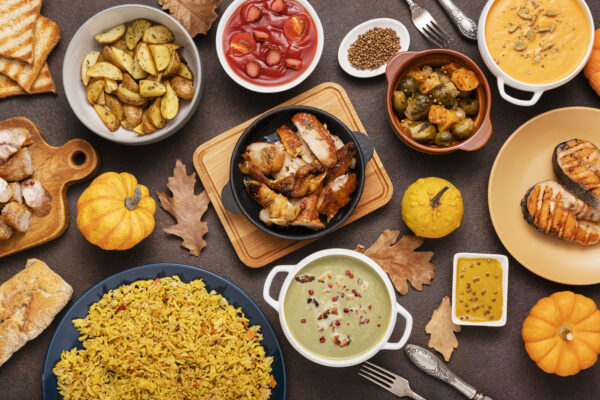Globetrotting Gastronomy: A Culinary Odyssey Across Continents in International Cuisine
Introduction:
Embark on a tantalizing voyage through the kaleidoscope of international cuisine, where flavors tell stories of distant lands and cultures. Join me as we traverse continents and delve into the heart of culinary traditions that have shaped global palates for centuries.
Asia: Where Tradition Meets Innovation
Japan: In Japan, culinary artistry is revered as a cultural heritage. Delicate sushi rolls whisper secrets of meticulous craftsmanship, while steaming bowls of ramen beckon with savory depth. Tempura dances lightly on the palate, celebrating simplicity in every crispy bite.
India: India’s spice-laden dishes are a symphony of flavors, each telling tales of regional diversity. From the aromatic biryanis of Hyderabad to the tangy chaats of Mumbai’s street corners, every dish is a journey through centuries of culinary evolution. Indulge in the creamy textures of paneer tikka and the crisp perfection of masala dosa.
Europe: A Tapestry of Taste
Italy: In Italy, food is a love language spoken with fresh ingredients and timeless recipes. Thin-crusted pizzas adorned with sun-ripened tomatoes and fragrant basil sing of Mediterranean sunsets. Pasta, lovingly draped in rich sauces, invites diners to savor each twirl. Indulge in the decadence of tiramisu and the comforting embrace of gnocchi.
France: France enchants with its culinary finesse, where every bite is a nod to culinary mastery. From the buttery croissants of Parisian cafes to the robust flavors of coq au vin simmered in red wine, French cuisine celebrates life’s simple pleasures. Delight in the elegance of escargot and the rustic charm of bouillabaisse.

Africa: Essence of Tradition
Morocco: Moroccan cuisine is a tapestry woven with spices and shared around communal tables. Tagines reveal slow-cooked stories of tender meats and sweet dried fruits. Couscous, delicate and fluffy, mirrors the warmth of Moroccan hospitality. Let the aroma of mint tea and the richness of pastilla transport you to bustling souks.
Ethiopia: In Ethiopia, culinary traditions are steeped in rituals that honor ancient flavors and communal dining. Injera, with its tangy bite, cradles savory stews and vibrant salads. Savor the boldness of doro wat, a spicy chicken stew, and the robustness of kitfo, seasoned raw beef. Experience the warmth of Ethiopian coffee ceremonies, a testament to the country’s rich cultural heritage.
Americas: Fusion of Flavors
Mexico: Mexico’s vibrant cuisine bursts with color and flavor, a celebration of indigenous ingredients and Spanish influences. Tacos, with their myriad fillings, invite diners to explore culinary creativity. Enchiladas, bathed in fiery sauces, offer a taste of Mexico’s bold spirit. Indulge in the sweetness of churros and the creamy allure of guacamole.
Peru: Peruvian cuisine blends ancient traditions with global influences, creating dishes that dazzle the senses. Ceviche, kissed by citrus, showcases the bounty of Peru’s coastal waters. Lomo saltado, a fusion of beef and Asian stir-fry techniques, embodies Peru’s cultural melting pot. Delight in the smoky flavors of anticuchos and the richness of quinoa dishes.
Conclusion:
Embarking on a culinary journey through international cuisine is more than a feast for the senses—it’s a celebration of diversity, heritage, and the universal joy of sharing a meal. Whether you’re savoring the delicate flavors of Japanese sushi or diving into the robustness of Ethiopian stews, each dish invites you to explore, learn, and appreciate the world’s rich culinary tapestry.
Bon appétit and happy globetrotting!
FAQs:
1. What makes international cuisine so captivating?
International cuisine is a vibrant mosaic of flavors, techniques, and ingredients that reflect the unique cultural identities of diverse regions worldwide. From the delicate artistry of Japanese sushi to the hearty warmth of Moroccan tagine, each dish tells a story steeped in tradition and innovation, making international cuisine a delightful exploration for food enthusiasts everywhere.
2. How can I explore global flavors without leaving home?
Embarking on a culinary journey from your kitchen is easier than you think! Dive into the vast expanse of international recipes available online or in cookbooks. Experiment with authentic ingredients sourced from local ethnic markets to capture the essence of each culture’s culinary heritage. Transform your dining table into a global feast and savor the excitement of discovering new tastes and textures.
3. What are some quintessential ingredients in international cuisine?
International cuisine boasts a diverse palette of ingredients that vary from region to region. Think fragrant spices like saffron in Persian cuisine, aromatic herbs like cilantro in Mexican dishes, or staple grains like couscous in North African fare. These elements not only define the flavors but also provide a glimpse into the cultural fabric that weaves these culinary traditions together.
4. How do I pair wines with international dishes?
Pairing wine with international cuisine is an art that blends flavors and enhances dining experiences. Consider the intensity and profile of the dish—spicy Asian cuisine might harmonize with a crisp Riesling, while robust Italian pasta calls for a velvety Chianti. Embrace experimentation and allow your palate to guide you towards discovering delightful combinations that elevate your dining adventures.
5. What cultural etiquettes should I observe when enjoying international cuisine?
Delving into international cuisine invites you to embrace cultural etiquettes that enrich your dining experience. Respect traditions such as using chopsticks in Asian cultures or savoring a mezze spread in Middle Eastern settings. Show appreciation by learning dining customs and demonstrating openness to new flavors, fostering a deeper connection to the culinary heritage of each region.
6. How can I infuse international flavors into everyday meals?
Infusing everyday meals with international flavors is a culinary playground ripe with creativity. Experiment with global spices like garam masala in soups or Japanese miso in marinades to add depth and intrigue. Incorporate techniques such as stir-frying from Asian cuisines or slow-roasting from Mediterranean traditions to transform familiar dishes into inspired culinary creations.
7. Where can I find authentic international cuisine restaurants?
Authentic international cuisine restaurants often thrive in cultural enclaves or vibrant urban centers celebrated for their diversity. Seek recommendations from local communities, explore online reviews, or immerse yourself in food festivals showcasing global fare. Discovering hidden gems and beloved eateries allows you to embark on culinary adventures that celebrate authenticity and tradition.
8. How can I delve deeper into the cultural background of international dishes?
Uncovering the cultural roots of international dishes unfolds a tapestry of history and tradition waiting to be explored. Delve into literature, documentaries, or culinary workshops that illuminate the origins and significance of iconic recipes. Engage with chefs, attend cultural events, and travel to the heartlands of these cuisines to gain firsthand insights into the stories behind the flavors that captivate the world.
9. What health benefits can I derive from exploring international cuisine?
Exploring international cuisine offers a bounty of health benefits rooted in diverse culinary practices. Mediterranean diets rich in olive oil and fresh produce promote heart health, while the nutrient-dense profiles of Asian cuisines emphasize balance and longevity. Embrace the nourishing properties of global ingredients and recipes to cultivate a well-rounded approach to wellness through the pleasures of culinary exploration.
10. How does enjoying international cuisine contribute to celebrating cultural diversity?
Savoring international cuisine is more than a culinary delight—it’s a celebration of cultural diversity and global unity. By patronizing local eateries, sharing meals with friends and family, and embracing flavors from around the world, you actively promote cultural appreciation and understanding. Your journey through international cuisine fosters a deeper connection to global traditions, enriching your worldview and igniting a passion for culinary exploration that transcends borders.




